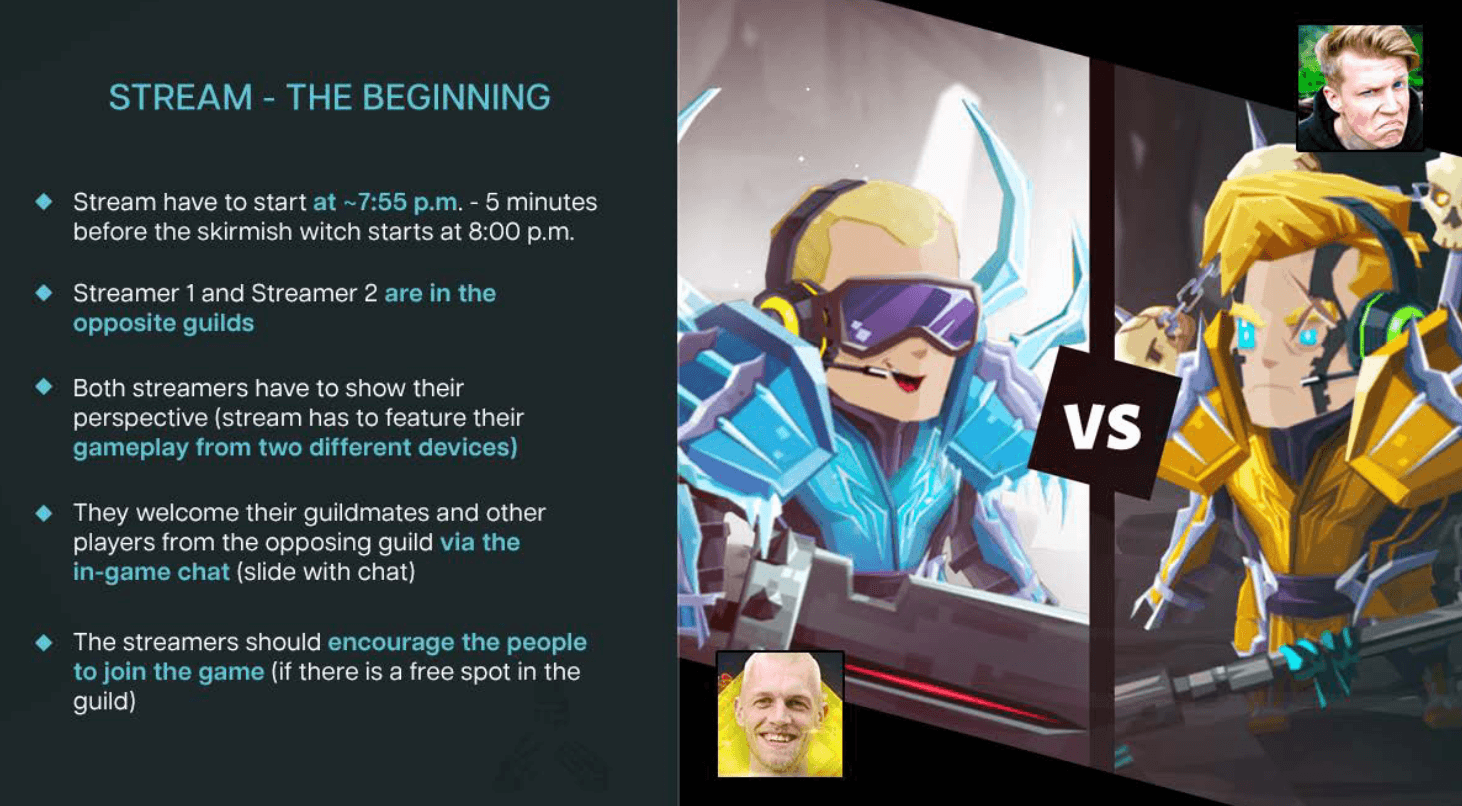Influencer Briefing: 7 Things To Include
The best influencer briefs balance out creative freedom with brand guidelines and business goals. Giving too many requirements & restrictions to creators will make your collaboration appear forced and inauthentic.
The trick is to provide the maximum possible creative freedom, while also:
Preparing a brief template that checks those boxes is going to speed up your workflow drastically. Not to mention improving the creative output at the same time.
TL;DR? Here’s our template. Make a copy and customize it for your brand ????.
What is an influencer brief
An influencer brief is a document that details everything a creator needs to know about working with a brand. A brief should contain direction & guidelines for content creation, plus business information like goals, company/product information, timelines and more.
Providing clear influencer briefs:
7 things to include for an effective & concise influencer brief
To keep your briefs concise, I’d recommend you write a very short introduction to your company and/or product. Instead of going into detail here, provide links to where the creator can learn more.
Consider sharing links to pages like About, Team, and Product pages that are relevant. David Hoos from Outloud Group (an influencer marketing agency) recommends sharing real product reviews:
You could also share (or link to) your media kit & logo here.
Here’s where you’ll introduce the specific campaign you want to collaborate for. Include the most important details:
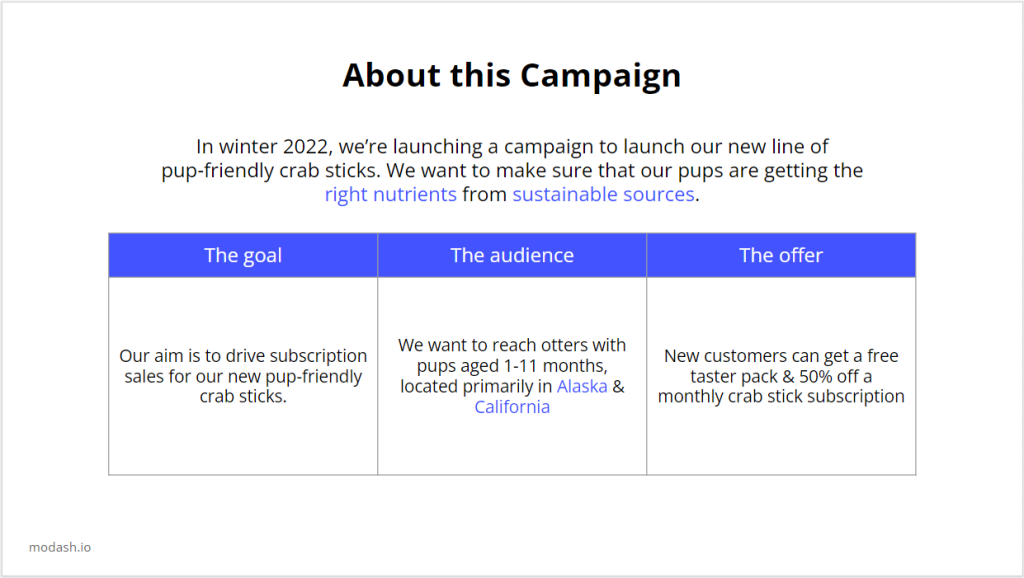
What does success look like? Make sure creators understand the goal of the campaign, and which metrics/KPIs you’ll be measuring to determine the success.
Keep in mind that not all creators are familiar with analytics & conversion tracking. Especially micro influencers. Depending on who you’re working with, it could be a good idea to keep the technical language & acronyms to a minimum.
Keep it simple for all parties. Choose one KPI that’s easy to understand & supports your goal.
For example:
“Our goal is to sell monthly crab stick subscriptions. In order to track our success & ensure you’re credited for sales, we’ll give you a unique link & promo code. The primary KPI we’ll use to measure success is how many times your promo code is used.”
Even if you are personally tracking more influencer KPIs (e.g. clicks, adds to cart, social reach & engagement etc.), just sharing one KPI in your brief helps to increase clarity & focus.
If you can, add some extra tips. What can the creator do that helps them increase the KPI? It could be something basic like remembering to add their promo code & a clear CTA in captions.
Write down what you expect from creators, and when. That way, there are no surprises for either side. If relevant, specify the desired platforms and content formats.
If there’s a content review process, make sure that’s specified in your timeline.
For videos, you could choose to be more specific. E.g. requesting a certain length, resolution, or other requirement.
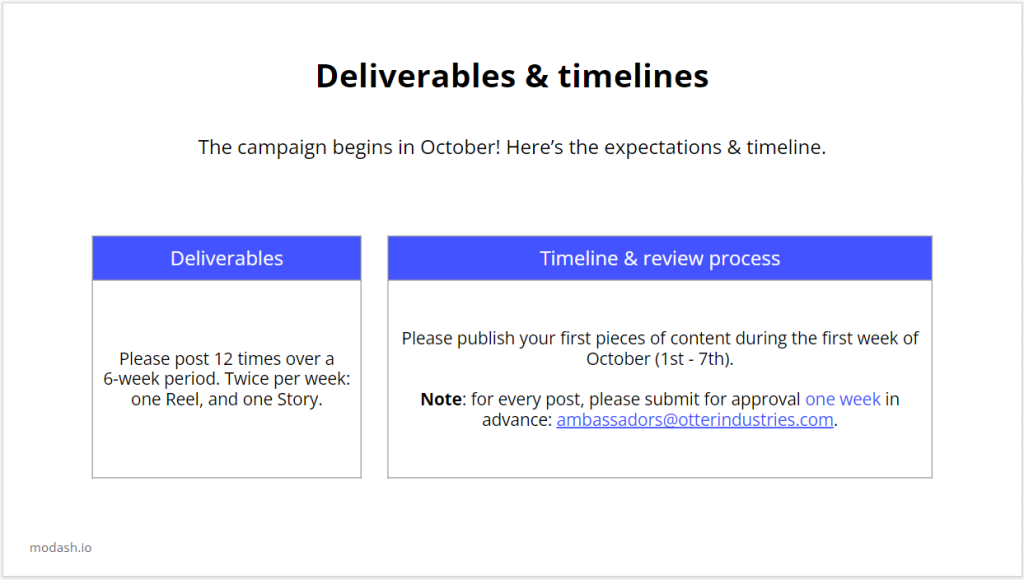
Add some direction for writing a post caption. Include the necessary hashtags, and remind creators about ad disclosure.
You could provide a few bullet points or key messages that a creator could use in their caption.
Here’s an example of a content brief for Veriff. The goal was to position Veriff as an attractive employer in Estonia. The writer used ‘fun facts’ like these to prompt caption ideas:
If you plan to prompt ideas in a similar way, remember not to simply list out your product features. Think about interesting angles, the pains you’re solving, or the benefits of your features. For example:
❌ Our crab sticks have 8g protein per stick
✅ 65% of otter pups are malnourished because they don’t get enough protein in their diet. Our crab sticks are an easy source of protein with 8g per stick.
Think about providing guardrails. Like with the caption, you want to maintain that creative freedom, but you still need to make sure the campaign & content aligns with your goals.
Give as many examples as possible. Past content that you liked, and/or a moodboard showing the general style that fits your brand.
If you do have any specific creative requirements, mention them here. Here’s a few examples that a brief could include:
Payment information is something you might already have discussed separately. It should be in your influencer contract, or at least agreed in writing via email. To reduce any potential questions from creators, you could reiterate this information at the end of the brief.
If rates vary based on negotiations with different influencers, you can still write down general information without specifying the exact rate. For example:
“All invoices should be submitted to ambassadors@otterindustries.com after the campaign is completed. Here’s our details to address your invoice.”
Use our free influencer brief template
There’s lots of ways to prepare an influencer creative brief. Our template uses Google Slides, but that’s not the only way. It can be a Google Doc, a PDF, a video, an email, or anything else. As long as you can find a way to communicate the most important points (above), you’re good. Don’t stress about the format, and don’t overthink it.
To get started quickly, you can use our influencer brief template. Open it up, hit ‘File’, and make a copy. Customize it to suit your brand.
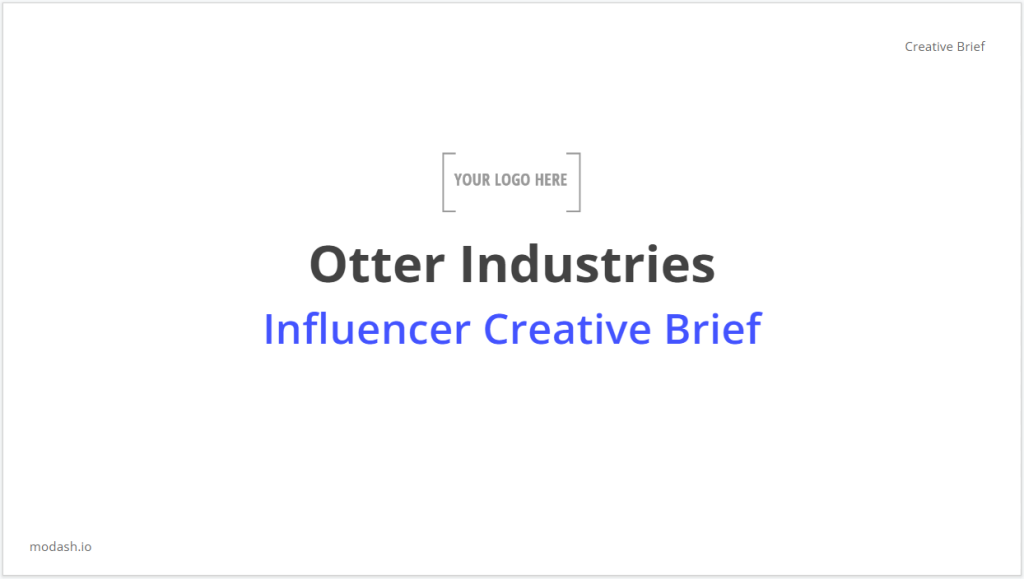
How to keep track of influencer content
You’ve sent your briefs, and content starts to go live. Great! What’s next?
Depending on how many creators you’re working with, it could start to get very cumbersome to keep track of content.
Answering these questions manually is time consuming & painful. Screenshotting Stories every day before they disappear? No thanks.
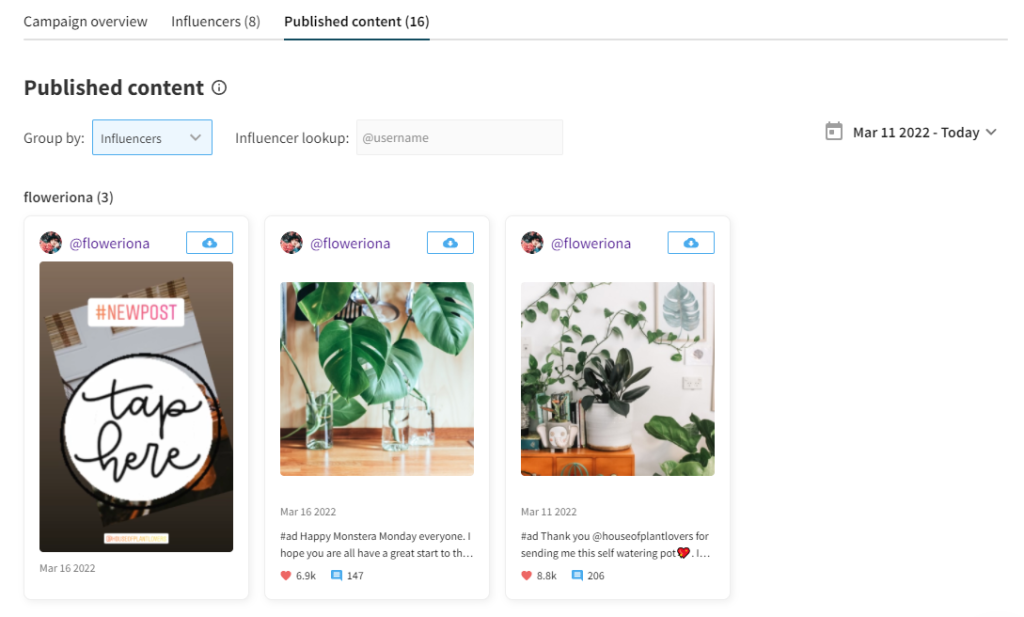
With that, you can very quickly check one place to spot any creatives that don’t meet your guidelines. Equally, you might catch an amazing creative that you want to share with your other ambassadors.
You can also get an overview per influencer, to simply see how many times they’ve posted (in which formats), and the reach achieved. That makes it very easy to see who’s doing well, and if you need to follow up & help anyone.
Influencer brief examples
We’ve already seen a couple of example briefs from Veriff and WeFast, as well as our Google Slides template. Here’s 3 more examples from our friends in the influencer marketing world to get inspired.
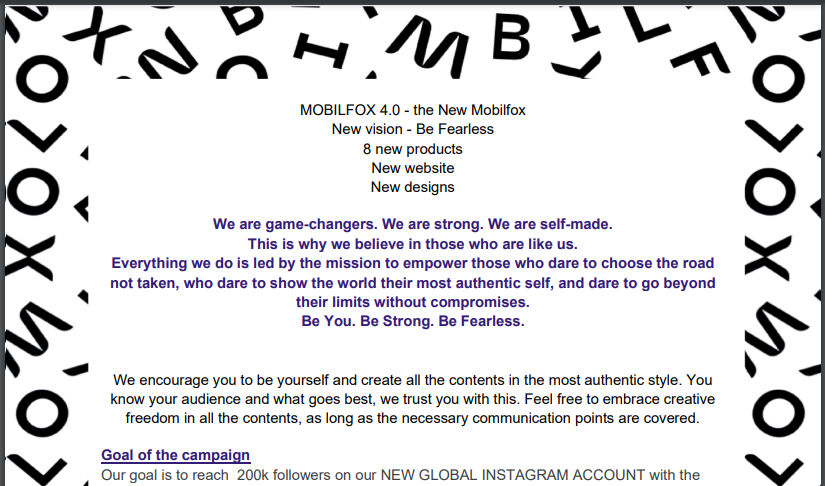
In this example, Mobilfox emphasize their brand, positioning, and values. They make the goal very clear (gain followers on a new IG account). They also provide content guidelines (what to post & when), without being overly restrictive. For example, they request that influencers post a ‘haul’ style Story set, but they leave it to the creator to choose which products they’ll show & why according to their own style.
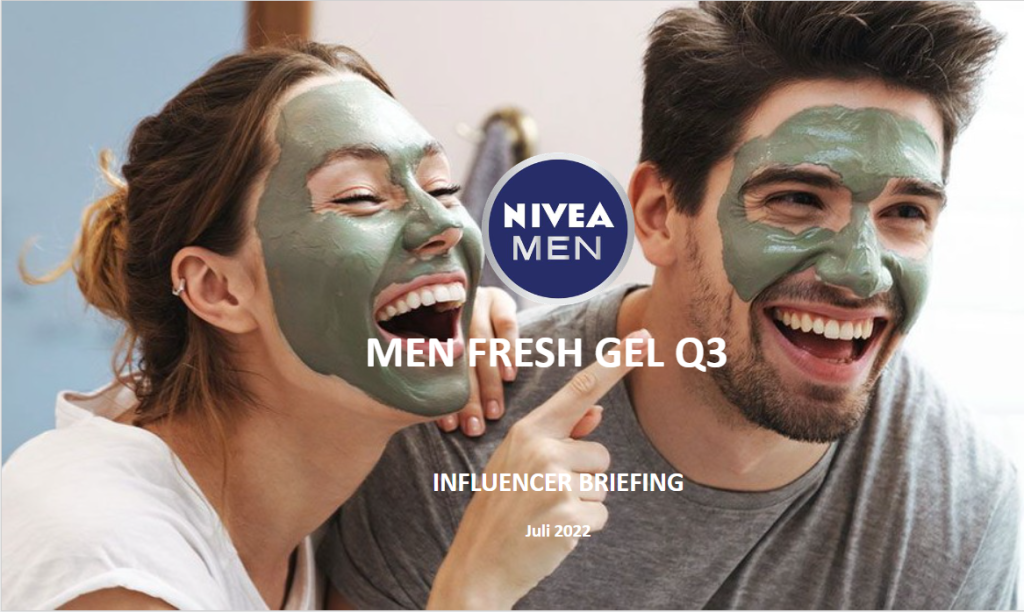
This brief is in Dutch, unfortunately (unless you speak Dutch, then you’re golden!). We’ve translated the headings, and you can get the gist of the general layout & approach.
Nivea give ideas, but encourage creators to come up with their own creative hook. Specifically, they ask that creators convey their key messages in their own words.
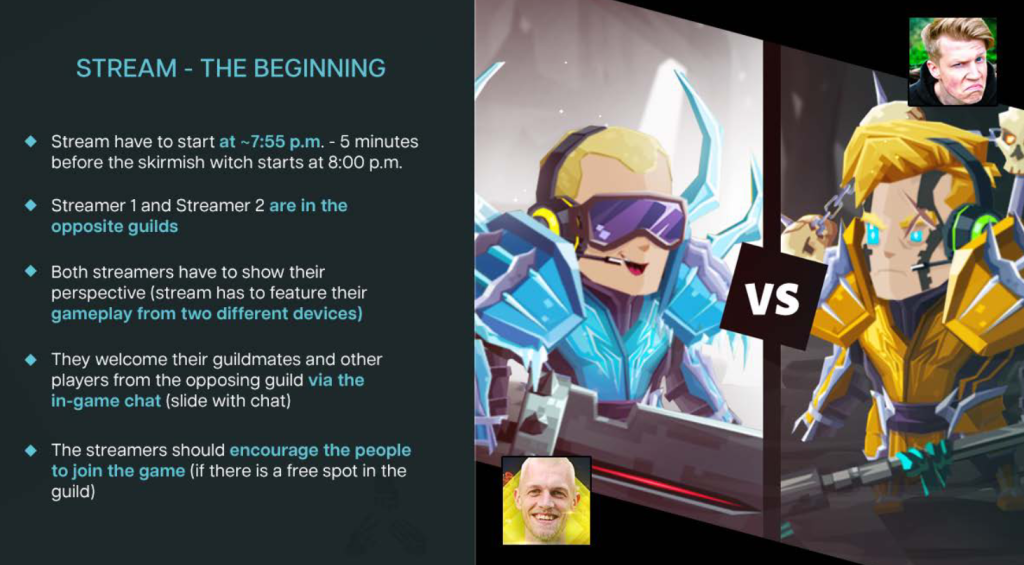
Something a little different for our last example. Here’s a brief for Twitch influencers before a live stream.
There’s a little more detail in this one, to explain the format of the game. That said, Gamesture still take care to make sure the creators understand their goals. In this case, to make the viewers feel enjoyment & excitement.
